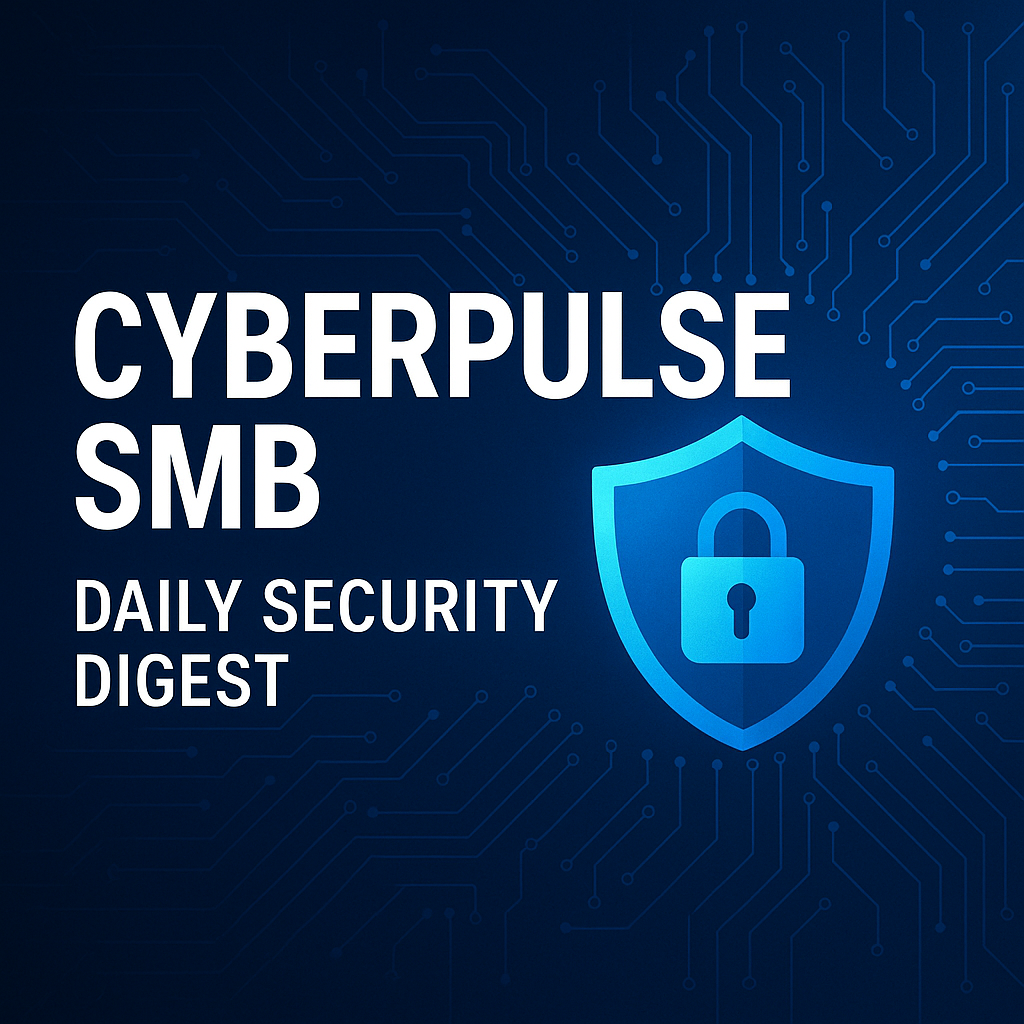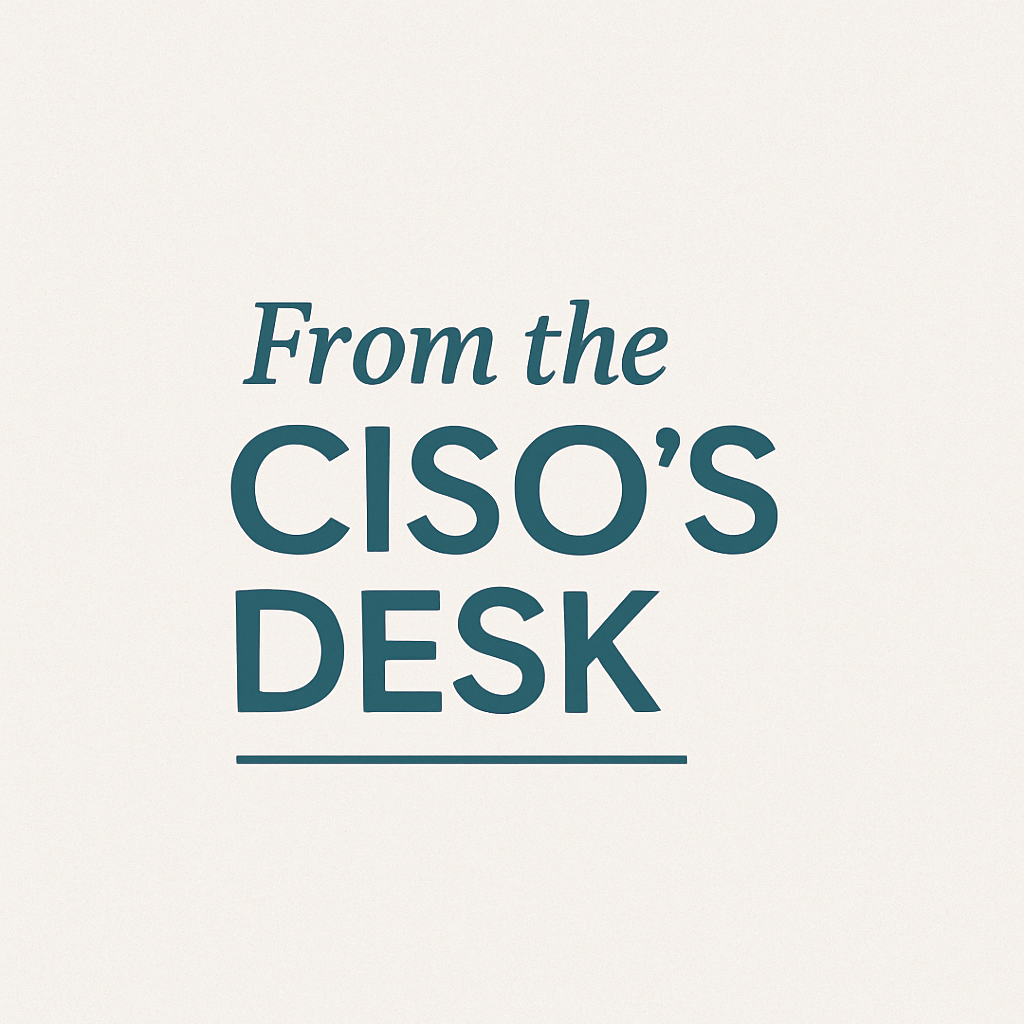🧠 CyberPulse SMB: Daily Security Digest

Date: September 17, 2025
⚠️ What Every Business Leader Should Know
Cyberattacks targeting small and mid-sized businesses are rising fast—and they’re getting more sophisticated. The threats aren’t just technical—they affect your operations, customer trust, and bottom line. Below is a plain-language breakdown of what’s happening and what actions you should take.
🔴 High-Risk Issues
🔐 Passwords and Email Attacks Are Still the Top Entry Point
Hackers are targeting your staff with realistic phishing emails, often impersonating services like Gmail, Outlook, or Plaid to steal login credentials.
Business Risk: One employee clicking the wrong link can expose your email systems, customer data, or financial accounts.
Actions:
- Require multi-factor authentication (MFA) for all accounts.
- Enforce strong password policies and train employees to spot fake emails.
- Simulate phishing tests to build awareness.
💥 Ransomware Attacks Are More Dangerous Than Ever
Criminal groups are deploying HybridPetya-style ransomware that locks your systems and demands payment. SMBs are especially vulnerable due to limited backups or outdated software.
Business Risk: Total loss of access to systems or data. Downtime could last days or weeks.
Actions:
- Back up your data offline or in a secure cloud.
- Test your ability to recover from backups.
- Develop a simple incident response plan.
🧩 Your Vendors Could Be Your Weakest Link
Malicious code in widely used software tools—especially npm packages used by developers—can serve as a hidden doorway for attackers.
Business Risk: A trusted vendor or tool could introduce malware into your environment without your knowledge.
Actions:
- Vet vendors and software providers carefully.
- Review contracts for clear security responsibilities.
- Use tools that scan your software dependencies for known vulnerabilities.
🌐 Cloud Apps & SaaS Platforms Are Being Exploited
Attackers are compromising platforms like Salesforce and other SaaS tools to steal data.
Business Risk: Confidential customer or financial data could be leaked or manipulated.
Actions:
- Enable MFA on all cloud accounts.
- Limit who has access to what.
- Use data loss prevention (DLP) tools to monitor sensitive data.
⚙️ Foundational Policy Risks
🗓️ Outdated Systems Create Hidden Exposure
Many SMBs still run unpatched versions of Windows, SAP, or MacOS—and attackers know it.
Business Risk: Known vulnerabilities are being exploited every day. You may not even know your system is at risk.
Actions:
- Implement automatic updates across all systems.
- Assign a person or vendor to manage patching if you don’t have internal IT staff.
🧱 Weak Internal Security Practices
Lack of formal policies—like password rules or access control—leads to inconsistent and risky behavior across your team.
Business Risk: Inconsistent practices increase the odds of a breach and may create compliance gaps.
Actions:
- Adopt basic security policies: passwords, device use, remote access, backups.
- Train your staff regularly on what’s expected.
🕸️ Flat Networks Multiply the Damage
Most SMB networks are “flat,” meaning once an attacker gets in, they can access everything.
Business Risk: A single point of failure could expose your entire business.
Actions:
- Isolate sensitive systems or customer data from the rest of your network.
- Require extra authentication for admin access.
📢 Security Awareness Gaps
🧠 Generic Training Isn’t Enough
Most employees don’t remember security tips from an annual PowerPoint.
Business Risk: Human error remains the #1 cause of data breaches.
Actions:
- Use realistic phishing simulations regularly.
- Train staff to recognize social engineering (urgency, fake invoices, impersonation).
- Keep sessions short, interactive, and scenario-based.
🧾 No Response Plan = Panic
Many SMBs have no idea what to do when something goes wrong.
Business Risk: Delayed responses, poor communication, lost data, or legal exposure.
Actions:
- Create a simple incident response checklist:
- Who to call
- What to shut down
- How to notify affected parties
📦 What You Should Prioritize Now
Here’s a business-friendly action plan:
| ✅ Priority | 📌 Action Item |
|---|---|
| 🔐 Account Security | Enable MFA on all systems, especially email & cloud |
| 💾 Data Protection | Back up data regularly and test your recovery process |
| 🧑💻 Employee Training | Run phishing simulations and short training sessions |
| 📦 Vendor Management | Vet software suppliers and scan for risky dependencies |
| 🧰 Software Updates | Automate updates for all systems and devices |
| 🧱 Network Hardening | Segment sensitive systems from general access |
| 📄 Policy Coverage | Write and enforce basic IT and security policies |
| 🛑 Incident Response | Create a simple breach response plan |
💬 Final Thought
Cybersecurity doesn’t need to be expensive—but doing nothing is. The cost of a single breach can exceed what you’d spend protecting your business for 3–5 years.
Start small, but start now.
Because when it comes to security, the best ROI comes from the basics done right.
Want help implementing these steps? Subscribe to the CyberPulse SMB newsletter or explore our SMB Cybersecurity Toolkit for templates, checklists, and training.
🔗 Additional Reading
High-Risk
- https://thehackernews.com/2025/09/from-quantum-hacks-to-ai-defenses.html
- https://thehackernews.com/2025/09/scattered-spider-resurfaces-with.html
- https://thehackernews.com/2025/09/doj-resentences-breachforums-founder-to.html
- https://www.darkreading.com/vulnerabilities-threats/ai-powered-sign-up-fraud-scaling-fast
- https://www.darkreading.com/application-security/self-replicating-shai-hulud-worm-npm-packages
- https://krebsonsecurity.com/2025/09/self-replicating-worm-hits-180-software-packages/
- https://go.theregister.com/feed/www.theregister.com/2025/09/17/breachforums_founder_prison/
- https://go.theregister.com/feed/www.theregister.com/2025/09/17/uk_telco_colts_cyberattack_recovery/
- https://isc.sans.edu/diary/rss/32294
- https://www.bleepingcomputer.com/news/security/breachforums-hacking-forum-admin-resentenced-to-three-years-in-prison/
- https://www.bleepingcomputer.com/news/security/google-nukes-224-android-malware-apps-behind-massive-ad-fraud-campaign/
- https://www.bleepingcomputer.com/news/security/self-propagating-supply-chain-attack-hits-187-npm-packages/
- https://www.bitdefender.com/en-us/blog/hotforsecurity/luxury-fashion-brands-gucci-balenciaga-and-alexander-mcqueen-hacked-customer-data-stolen
- https://www.schneier.com/blog/archives/2025/09/hacking-electronic-safes.html
- https://unit42.paloaltonetworks.com/why-innocent-clicks-dont-exist-in-cybersecurity/
- https://thehackernews.com/2025/09/new-filefix-variant-delivers-stealc.html
- https://thehackernews.com/2025/09/apple-backports-fix-for-cve-2025-43300.html
- https://thehackernews.com/2025/09/phoenix-rowhammer-attack-bypasses.html
- https://thehackernews.com/2025/09/40-npm-packages-compromised-in-supply.html
- https://www.darkreading.com/cyberattacks-data-breaches/killsec-ransomware-brazil-healthcare-software-provider
- https://www.darkreading.com/application-security/-lies-in-the-loop-attack-ai-coding-agents
- https://go.theregister.com/feed/www.theregister.com/2025/09/16/filefix_attacks_facebook_security_alert/
- https://go.theregister.com/feed/www.theregister.com/2025/09/16/jlr_global_shutdown/
- https://isc.sans.edu/diary/rss/32286
- https://www.bleepingcomputer.com/news/security/jaguar-land-rover-extends-shutdown-after-cyberattack-by-another-week/
- https://www.bleepingcomputer.com/news/security/apple-backports-zero-day-patches-to-older-iphones-and-ipads/
- https://www.bleepingcomputer.com/news/security/new-filefix-attack-uses-steganography-to-drop-stealc-malware/
- https://www.bleepingcomputer.com/news/security/webinar-your-browser-is-the-breach-securing-the-modern-web-edge/
- https://www.schneier.com/blog/archives/2025/09/microsoft-still-uses-rc4.html
- https://securelist.com/revengehotels-attacks-with-ai-and-venomrat-across-latin-america/117493/
- https://unit42.paloaltonetworks.com/code-assistant-llms/
- https://research.checkpoint.com/2025/under-the-pure-curtain-from-rat-to-builder-to-coder/
- https://thehackernews.com/2025/09/6-browser-based-attacks-security-teams.html
- https://thehackernews.com/2025/09/weekly-recap-bootkit-malware-ai-powered.html
- https://thehackernews.com/2025/09/hiddengh0st-winos-and-kkrat-exploit-seo.html
- https://go.theregister.com/feed/www.theregister.com/2025/09/15/north_korea_chatgpt_fake_id/
- https://go.theregister.com/feed/www.theregister.com/2025/09/15/china_nvidia_antitrust/
- https://www.bleepingcomputer.com/news/security/new-voidproxy-phishing-service-targets-microsoft-365-google-accounts/
- https://securelist.com/model-context-protocol-for-ai-integration-abused-in-supply-chain-attacks/117473/
- https://research.checkpoint.com/2025/15th-september-threat-intelligence-report/
Policy
- https://thehackernews.com/2025/09/rethinking-ai-data-security-buyers-guide.html
- https://grahamcluley.com/the-ai-fix-68/
- https://www.microsoft.com/en-us/security/blog/2025/09/16/microsoft-purview-innovations-for-your-fabric-data-unify-data-security-and-governance-for-the-ai-era/
- https://www.mdpi.com/2072-6694/17/18/3036
- https://www.darkreading.com/vulnerabilities-threats/building-resilient-it-infrastructure
- https://go.theregister.com/feed/www.theregister.com/2025/09/16/office_2019_2016_support/
- https://www.mdpi.com/2076-2615/15/18/2710
- https://go.theregister.com/feed/www.theregister.com/2025/09/15/oracle_spending_shares_opinion/
- https://www.bleepingcomputer.com/news/security/fbi-warns-of-unc6040-unc6395-hackers-stealing-salesforce-data/
- https://www.mdpi.com/1422-0067/26/18/8984
Awareness
- https://thehackernews.com/2025/09/raccoono365-phishing-network-shut-down.html
- https://isc.sans.edu/diary/rss/32290
- https://www.bleepingcomputer.com/news/security/microsoft-and-cloudflare-disrupt-massive-raccoono365-phishing-service/
Emerging
- https://www.darkreading.com/cyberattacks-data-breaches/north-korean-group-south-military-id-deepfakes
- https://www.darkreading.com/endpoint-security/ray-security-protect-data-security
- https://go.theregister.com/feed/www.theregister.com/2025/09/17/return_on_investment_for_copilot/
- https://go.theregister.com/feed/www.theregister.com/2025/09/17/sky_plans_to_ditch_up/
- https://isc.sans.edu/diary/rss/32292
- https://www.bleepingcomputer.com/news/microsoft/microsoft-rolls-out-copilot-chat-to-microsoft-365-office-apps/
- https://openssf.org/blog/2025/09/16/new-openssf-guidance-on-ai-code-assistant-instructions/
- https://www.mdpi.com/2073-4360/17/18/2511
- https://thehackernews.com/2025/09/securing-agentic-era-introducing.html
- https://www.darkreading.com/cyber-risk/securityscorecard-buys-ai-automation-capabilities-boosts-vendor-risk-management
- https://go.theregister.com/feed/www.theregister.com/2025/09/16/safe_c_proposal_ditched/
- https://go.theregister.com/feed/www.theregister.com/2025/09/16/campaigners_urge_eu_to_mandate/
- https://isc.sans.edu/diary/rss/32288
- https://www.bleepingcomputer.com/news/artificial-intelligence/openais-new-gpt-5-codex-model-takes-on-claude-code/
- https://tailscale.com/blog/self-hosted-git-server-tailscale-forgejo
- https://www.mdpi.com/2073-4441/17/18/2736
- https://thehackernews.com/2025/09/ai-powered-villager-pen-testing-tool.html
- https://go.theregister.com/feed/www.theregister.com/2025/09/15/finwise_insider_data_breach/
- https://isc.sans.edu/diary/rss/32284
- https://www.bleepingcomputer.com/news/microsoft/microsoft-says-windows-september-updates-break-smbv1-shares/
- https://www.bleepingcomputer.com/news/microsoft/microsoft-reminds-of-windows-10-support-ending-in-30-days/
- https://www.schneier.com/blog/archives/2025/09/lawsuit-about-whatsapp-security.html
- https://www.schneier.com/blog/archives/2025/09/upcoming-speaking-engagements-48.html
- https://tailscale.com/blog/tailscale-sharing-friends-family
- https://www.mdpi.com/2412-3811/10/9/242
- https://www.mdpi.com/2673-7272/5/3/79
- https://www.mdpi.com/2073-431X/14/9/386
- https://www.mdpi.com/2075-4698/15/9/258
Controls
Other
- https://www.darkreading.com/cyber-risk/critical-bugs-chaos-mesh-cluster-takeover
- https://go.theregister.com/feed/www.theregister.com/2025/09/17/java_25_released/
- https://www.darkreading.com/cyberattacks-data-breaches/fbi-warns-threat-actors-salesforce-customers
- https://go.theregister.com/feed/www.theregister.com/2025/09/15/starlink_outage/
- https://www.bleepingcomputer.com/news/microsoft/microsoft-fixes-windows-11-audio-issues-confirmed-in-december/
- https://go.theregister.com/feed/www.theregister.com/2025/09/14/destroy_data_company_laptops_or_else/
- https://go.theregister.com/feed/www.theregister.com/2025/09/14/galaxy_fold7_foldable_smartphones_rising/
- https://www.mdpi.com/1422-0067/26/18/8953
📥 Subscribe or Contribute
Join the CyberPulse email digest or email morgan@sprico.com to submit an article or recommendation.
